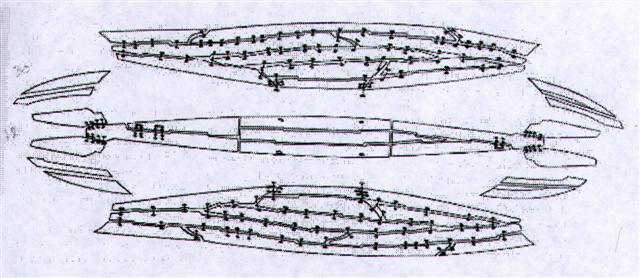Once again. I have stated that he beginning of the text was at nakshatra Acrux:
And now we have seen that nakshatra Acrux evidently could have been also at the last heke - given an adjustment of the time frame from that of rongorongo to that 3 precessional days earlier:
734 (Cb14-13) - Ca1-1 (1) = 733 = 365 + 365 + 3. For side a on the tablet I have assumed the heliacal stars were defining time, but on side b the nakshatra stars seem to be the guides. From Aldebaran to Antares there were 181 days, but from Antares to Aldebaran there were 181 + 3 = 184 days. ... Vainamoinen set about building a boat, but when it came to the prow and the stern, he found he needed three words in his rune that he did not know, however he sought for them. In vain he looked on the heads of the swallows, on the necks of the swans, on the backs of the geese, under the tongues of the reindeer. He found a number of words, but not those he needed. Then he thought of seeking them in the realm of Death, Tuonela, but in vain. He escaped back to the world of the living only thanks to his potent magic. He was still missing his three runes. He was then told by a shepherd to search in the mouth of Antero Vipunen, the giant ogre. The road, he was told, went over swords and sharpened axes. Ilmarinen made shoes, shirt and gloves of iron for him, but warned him that he would find the great Vipunen dead. Nevertheless, the hero went. The giant lay underground, and trees grew over his head. Vainamoinen found his way to the giant's mouth, and planted his iron staff in it. The giant awoke and suddenly opened his huge mouth. Vainamoinen slipped into it and was swallowed. As soon as he reached the enormous stomach, he thought of getting out. He built himself a raft and floated on it up and down inside the giant. The giant felt tickled and told him in many and no uncertain words where he might go, but he did not yield any runes. Then Vainamoinen built a smithy and began to hammer his iron on an anvil, torturing the entrails of Vipunen, who howled out magic songs to curse him away. But Vainamoinen said, thank you, he was very comfortable and would not go unless he got the secret words. Then Vipunen at last unlocked the treasure of his powerful runes. Many days and nights he sang, and the sun and the moon and the waves of the sea and the waterfalls stood still to hear him. Vainamoinen treasured them all and finally agreed to come out. Vipunen opened his great jaws, and the hero issued forth to go and build his boat at last ...
On side a of the tablet Hamal (the Leader of the heliacal star flock) was ruling:
... Strassmeier and Epping, in their Astronomishes aus Babylon, say that there its stars formed the third of the twenty-eight ecliptic constellations, - Arku-sha-rishu-ku, literally the Back of the Head of Ku, - which had been established along that great circle milleniums before our era; and Lenormant quotes, as an individual title from cuneiform inscriptions, Dil-kar, the Proclaimer of Dawn, that Jensen reads As-kar, and others Dil-gan, the Messenger of Light. George Smith inferred from the tablets that it might be the Star of the Flocks; while other Euphratean names have been Lu-lim, or Lu-nit, the Ram's Eye; and Si-mal or Si-mul, the Horn star, which came down even to late astrology as the Ram's Horn. It also was Anuv, and had its constellation's titles I-ku and I-ku-u, - by abbreviation Ku, - the Prince, or the Leading One, the Ram that led the heavenly flock, some of íts titles at a different date being applied to Capella of Auriga. Brown associates it with Aloros, the first of the ten mythical kings of Akkad anterior to the Deluge, the duration of whose reigns proportionately coincided with the distances apart of the ten chief ecliptic stars beginning with Hamal, and he deduces from this kingly title the Assyrian Ailuv, and hence the Hebrew Ayil; the other stars corresponding to the other mythical kings being Alcyone, Aldebaran, Pollux, Regulus, Spica, Antares, Algenib, Deneb Algedi, and Scheat ... On side a the precessional clock had been updated to the time of rongorongo and I have arranged my structure accordingly. Therefore Hamal (*30) should have risen with the Sun in April 20 (110 = 80 + *30) both at Ca2-1 (27) and at *Ca14-29 (392). 27 + 365 = 392. But in order to join the flow of glyphs on side a to that on side b without any discontinuity I have used the time frame on side b also for the dates on side a. Therefore *392 (= *27 + 365) at April 17 corresponds to April 20 (*30 + 365 = *395). I have assumed the text was used as a single calendar cycle without any discontinuities.
|
||||||||||||||||||||||||||||||||||||||||||||||||||||||||||||||||||||||||||||||||||||||||||||||||||||||||||||||||||||||||||||||||||||||||||||||||||||||||||||||||||||||||||||||||||||||||||||||||||||||












